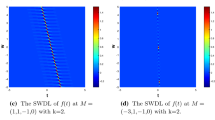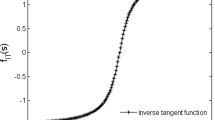Abstract
Based on both the lower and the upper triangular Cholesky decomposition algorithms, the (inverse) lower triangular Cholesky integer transformation and the (inverse) upper triangular Cholesky integer transformation are defined, and the (inverse) paired Cholesky integer transformation is proposed. Then, for the case of high-correlation ambiguity, a multi-time (inverse) paired Cholesky integer transformation is given. In addition, a simple and practical criterion is presented to solve the uniqueness problem of the integer transformation. It is verified by an example that (1) the (inverse) paired Cholesky integer transformation is very convenient and very efficient in practical computation; (2) the (inverse) paired Cholesky integer transformation is better than both the (inverse) lower triangular Cholesky integer transformation and the (inverse) upper triangular Cholesky integer transformation; and that (3) the inverse paired Cholesky integer transformation outperforms the paired Cholesky integer transformation slightly in the most cases.
Similar content being viewed by others
References
Cai J, Grafarend EW, Hu C (2009) The total optimal search criterion in solving the mixed integer linear model with GNSS carrier phase observations. GPS Solut 13(3):221–230
Jonge PJ de, Tiberius CCJM (1996) The Lambda method for integer ambiguity estimation: implementation aspects. In: Delft Geodetic Computing Center LGR-series, no 12. pp 1–49
Golub GH, Van Loan CF (1993) Matrix computation, 2nd edn edn. The Johns Hopkins University Press, Baltimore
Grafarend E (2000) Mixed integer-real valued adjustment (IRA) problems. GPS Solut 4:31–45
Hassibi A, Boyd S (1998) Integer parameter estimation in linear models with applications to GPS. IEEE Trans Signal Proc 46:2938–2952
Hofmann-Wellenhof B, Lichtenegger H, Wasle E (2008) GNSS global navigation satellite systems, GPS, GLONASS, Galileo & more. Springer, Wien
Leick A (2004) GPS satellite surveying, 3rd edn edn. Wiley, New York
Li Z, Gao Y (1998) A method for the construction of high dimensional transformation matrices in LAMBDA. Geomatica 52:433–439
Liu LT, Hsu HT, Zhu YZ, Ou JK (1999) A new approach to GPS ambiguity decorrelation. J Geod 73:478–490
Lou L, Grafarend E (2003) GPS integer ambiguity resolution by various decorrelation methods. Zeitschrift für Vermessungswesen 3:203–210
Rizos C, Han S (1995) A new method for constraining multi-satellite ambiguity combinations for improved ambiguity resolution. In: Proc ION GPS-95, Palm springs, 12–15 September, pp 1145–1153
Strang G, Borre K (1997) Linear algebra, geodesy, and GPS. Cambridge Press, Wellesley
Teunissen PJG (1993) Least-squares estimation of the integer GPS ambiguities. Invited lecture, sect, theory and methodology. In: IAG general meeting, Beijing
Teunissen PJG (1994). A new method for fast carrier phase ambiguity estimation. In: Proceedings of PLANS’94, Las Vegas, NV, April 11–15, pp 562–573
Teunissen PJG (1995a) The invertible GPS ambiguity transformations. Manuscr Geod 20(6):489–497
Teunissen PJG (1995b) The least-squares ambiguity decorrelation adjustment: a method for fast GPS integer ambiguity estimation. J Geod 70:65–82
Teunissen PJG (1999) An optimality property of the integer least-squares estimator. J Geod 73:587–593
Teunissen PJG (2001) The probability distribution of the ambiguity bootstrapped GNSS baseline. J Geod 75:267–275
Teunissen PJG, Kleusberg A (eds) (1998) GPS for geodesy, 2nd edn edn. Springer, Berlin, pp 262–333
Teunissen PJG, De Jonge PJ, Tiberius CC (1997) The least-squares ambiguity decorrelation adjustment: its performance on short GPS baselines and short observation spans. J Geod 71:589–602
Xu P (2001) Random simulation and GPS decorrelation. J Geod 75:408–423
Zhou Y, Liu J (2003) Another form for LAMBDA method. Geo Spat Inf Sci (Quarterly) 6(3):66–70
Zhou Y, Liu J (2006) Return bootstrapping approach and its reliability. Surv Rev 38(299):368–378
Zhou Y, Liu J, Liu J (2005) Return-calculating LAMBDA approach and its search space. Actc Geodaetica et Cartographica Sinica 34(4):300–304
Acknowledgments
This study is supported by Key Laboratory of Advanced Engineering Surveying of SBSM (ES-SBSM-(07)-02).
Author information
Authors and Affiliations
Corresponding author
Rights and permissions
About this article
Cite this article
Zhou, Y. A new practical approach to GNSS high-dimensional ambiguity decorrelation. GPS Solut 15, 325–331 (2011). https://doi.org/10.1007/s10291-010-0192-6
Received:
Accepted:
Published:
Issue Date:
DOI: https://doi.org/10.1007/s10291-010-0192-6




